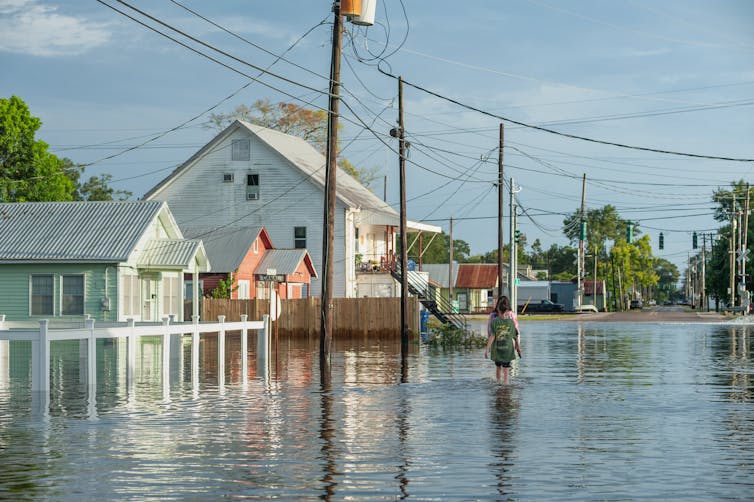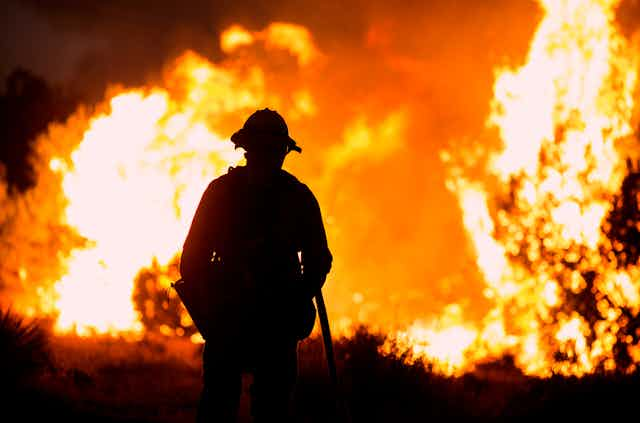Typically set in the future, climate fiction (or “cli-fi”) showcases the disastrous consequences of climate change and anticipates the dramatic transformations to come. Among the various scenarios cli-fi considers is unprecedented population displacement due to droughts and disappearing coastlines. These stories echo assessments from the International Organization for Migration, which warned as early as 1990 that migration would perhaps be the “single greatest impact of climate change”.
The scale of climate change, which has unfolded over generations and across the planet, is notoriously difficult to represent in fiction. Indian novelist Amitav Ghosh elaborated on this problem in The Great Derangement. According to Ghosh, the political failure to combat climate change is a symptom of a deeper failure in the cultural imagination. Simply put, how can people be expected to care about something (or someone) they can’t adequately visualise?
When it comes to representing climate migration, prominent US cli-fi takes on this imaginative problem by returning to familiar templates. These ideas operate under assumptions about what drives migration and depends upon prejudices about who migrants are. For example, in some of these stories characters will be noticeably shaped by the stereotype of “illegal” immigrants from Latin America.
Employing such well-known ideas can help get points across about a potential future but there is a more compelling way to represent climate migration. Stories can be grounded in reality without entrenching harmful stereotypes or disregarding the very real climate migrants who currently exist in the US today.
Precedents for climate migration
Paolo Bacigalupi’s novel, The Water Knife, is set around the US-Mexico border. Permanent drought in the Southwest has turned the region’s population into refugees who desperately seek passage into neighbouring states and — most optimistically — north into Canada.

The novel’s borderland setting is heavy with political subtext. The southern border looms large in anti-immigration campaigns, which perpetuate misleading claims that the region is under siege from migrant groups. However, the novel is less interested in dispelling these myths than in redirecting their emotional power.
Asking readers to imagine themselves in the shoes of Latin American migrants today is an effective tool in literature. For example, John Steinbeck’s The Grapes of Wrath famously asked readers to sympathise with Dust Bowl migrants at a time when so-called “Okies” were subject to disdain. But Steinbeck’s novel also helped readers imagine these migrants’ plight by stressing how thoroughly American (and white) they were.
However, The Water Knife tasks readers with imagining the whole of the US becoming a country like Mexico. Angel, a central character in the novel, remarks that the violence he sees in Arizona reminds him of “how it had been down in Mexico before the Cartel States took control completely.” The book suggests here that the problems that drive large scale migration are not unique to any single part of the world, which is good. But at the same time, it also imagines a scenario where the societal violence associated with Mexico moves into the US. The warning is “change your behaviour now, lest you make the US like Mexico”. This doesn’t serve to help readers understand Mexico or the plight of migrants but reinforces ideas that both are bad realities we would rather avoid – to become Mexico and a refugee is to fail but if you act now you can avoid becoming like them.
The Water Knife demonstrates how narratives that wish to raise awareness about the plight of climate migrants must tread carefully. Hoards of desperate migrants are a common motif in apocalyptic science fiction, but they are also familiar subjects in xenophobic political campaigns.
So long as people believe that climate migration will only become a problem for wealthy countries in the future, they might also believe that they can simply close their borders to the climate migrants when they come. In the meantime, dehumanising stereotypes about refugee armies obscure the very real harm facing migrants in the US today. So, while these stories want to encourage a more sympathetic view of migrants, they can have the opposite effect.
A contemporary American problem
But climate migration isn’t just a problem for less affluent countries in the future. It is well underway in the US.

From catastrophic wildfires on the West Coast to mega-hurricanes along the Gulf, environmental disasters already afflict large segments of the population. The effects of forced migration due to Hurricane Katrina in 2005, for example, are apparent in the lower rate of return of New Orleans’s Black population.
To highlight cli-fi’s shortfalls is not to undermine its important contributions to environmental activism. These are stories that want to do more than raise the alarm. They want us to think more proactively about responding to disaster and caring for others now. This sense of urgency might explain why much of cli-fi depends upon pre-existing (and flawed) migrant stereotypes rather than ones more in step with climate migration today. Perhaps it’s quicker to push people to action by mobilising old ideas than constructing new ones.
However, these stories need not look to foreign cases or draw outdated parallels to make climate migration a compelling scenario. Rather, they can look inward to the ongoing climate crises afflicting Americans today. That these affected groups are disproportionately Indigenous and people of colour should remind us that the dystopian elements of many cli-fi stories (widespread corruption, targeted violence, and structural inequality) are facts of everyday life for many in this country. People should be shocked that these things are happening under their noses, enough to inspire action now rather than later for problems in the distant future.

